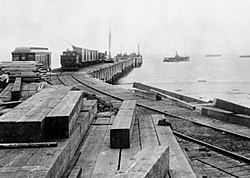McFadden Wharf
| McFadden Wharf | |
|---|---|
 McFadden Wharf in 1891 | |
| Location | near Newport Bay, California |
| Coordinates | 33°36′28″N 117°55′43″W / 33.6078611111111°N 117.928536111111°W |
| Built | 1888 |
| Designated | July 3, 1964 |
| Reference no. | 794 |
The place of McFadden Wharf was designated a
California Historic Landmark (No.794) on July 3, 1964.[1]
McFadden Wharf was built in what is today
U.S. Army Corps of Engineers for help in 1887. They told him it would take $1.2 million to improve the port, and rejected the request. In 1888 the McFadden brothers built their own wharf. The wharf was 1320 feet long and 60 feet wide. In 1891 they built the Santa Ana and Newport Railway railroad line from the wharf to the Santa Ana Depot, 11 miles long. A small town call Newport Landing was built near the Wharf. McFadden brothers had 100 employees and the shipping company was at last profitable. In 1896 they purchased more land in what is now Newport Beach. But port of San Pedro was bigger and closer to Los Angeles and shipping decreased. In 1899 James McFadden sold the wharf and railroad line to the Southern Pacific Transportation Company. The rail line closed in 1907.[2] In 1902, James sold the town of Newport Landing, half the Balboa Peninsula, and surrounding swamp lands to Williams S. Collins and C. A. Hanson. Collins, President of the Associated Oil Company, saw the town as a place to make a sea resort, not a shipping port. The team made Henry E. Huntington a partner in the Newport Beach development. In 1905, the Pacific Electric street cars ran to Newport, in 1906, the line continued to Balboa Peninsula and Balboa Pavilion. In 1939 the old McFadden Wharf was removed after being damaged by a large storm in 1928. In 1940 the current Newport Municipal Pier was built.[3][4][5][6][7][8]
| Old Landing | |
|---|---|
| Location | near Newport Bay |
| Built | 1870 |
| Designated | June 20, 1935 |
| Reference no. | 198 |
Old Landing
The place of Old Landing at San Joaquin Bay was designated a
California Historic Landmark (No.198) on June 20, 1935. A marker is at the spot that Newport Bay was opened to trade. Captain Samuel S. Dunnells and William A. Abbott opened the port for trade on September 10, 1870. The first ship to enter the bay was the 105-ton, flat-bottomed sternwheel steamer SS Vaquero with cargo of 15,000 shingles and 5,000 feet of lumber from San Diego. Samuel S. Dunnells built a small wharf called the Newport Landing. Newport Landing and Landing Warehouse was near the current Pacific Coast Highway and the Newport Bay Bridge. James McFadden and Robert McFadden purchased land and ran the port from April 19, 1875, till 1899, McFadden built a long wharf that opened in 1889. The landing was renamed Newport. The port and farm land around the port was owned by James Irvine, Benjamin Flint, James McFadden, and Robert McFadden.[9][10][11]
Markers
Marker at the McFadden Wharf site reads:
- "The original wharf at this site was completed in the winter of 1888–89 and was connected by railroad with the hinterland in the winter of 1890–91. It served as a shipping and distributing point for Orange, San Bernardino, and Riverside counties until 1907, and provided the nucleus from which developed the city of Newport Beach." Erected 1965 by California State Park Commission in cooperation with the City of Newport Beach. (Marker Number 794.)[12]
California Historical Landmarks records for McFadden Wharf reads:
- "No. 794 McFadden Wharf – The original wharf on this site was completed in the summer of 1888 by the McFadden brothers. As the seaward terminus of their Santa Ana and Newport Railway it became the funnel through which flowed a major part of the lumber and other goods that built Orange, San Bernardino, and Riverside Counties during the period from 1891 to 1907."[13]
Marker at the Old Landing, Newport Landing, site reads:
- "On September 10, 1870, Captain Samuel S. Dunnells and William A. Abbott opened Newport Bay to commerce when they entered it for the first time on the Sternwheel steamer Vaquero. The landing was designated "Newport" – a new port – by James Irvine, Benjamin Flint, james McFadden, and Robert McFadden. The McFaddens operated a regular shipping service here during the 1870s and 1880s." Erected 1935 by State Department of Parks and Recreation in cooperation with the Newport Beach Historical Society and City of Newport Beach. (Marker Number 198.)
See also
- California Historical Landmarks in Orange County, California
- Balboa Island, Newport Beach
- Bay Island (California)
References
- ^ "Orange: NO. 794 McFadden Wharf". Office of Historic Preservation. State of California. 2015. Retrieved 2015-05-06.
- ^ Staff (July 1981). "Past: Wave Goodbye to Beach Pleasures". Orange Coast Magazine: 87–89.
- ISBN 9781931112147.
- ^ "Balboa Island Newport Beach - Things to Do in Balboa Island Newport Beach". Balboa-island.net. Retrieved 2018-10-02.
- ^ "BIIA Island Guide: Island History". Archived from the original on 2011-07-25. Retrieved 2010-03-26.
- ^ "Newport Beach Historical Society | McFadden's Wharf – Castaways". newportbeachhistorical.org. Retrieved 2019-09-18.
- ^ Staff (May 12, 2015). "A look at the trains that built the O.C. coast". Los Angeles Times. Retrieved 2016-01-12.
- ^ "Los Angeles Basin's 1938 Catastrophic Flood Event". Archived from the original on 2009-05-09. Retrieved 2009-05-12.
- ^ "California Historic Parks Landmark, Old Landing". ohp.parks.ca.gov. Retrieved 2019-09-18.
- ^ "History of Balboa Island". Visit Newport Beach. Retrieved 2019-09-18.
- ^ Html5TemplatesDreamweaver.com. "SS Vaquero. San Francisco News and Tall Tales, Ship Passengers and Sea Captains. 1846–1899". maritimeheritage.org. Retrieved 2019-09-18.
{{cite web}}: CS1 maint: numeric names: authors list (link) - ^ "McFadden (Newport) Wharf Historical Marker". hmdb.org (Marker Database). 2016-06-16. Retrieved 2019-09-18.
- ^ Beatrice Delja. "CHL # 794 McFadden Wharf Orange". californiahistoricallandmarks.com. Retrieved 2019-09-18.
- ^ "Old Landing Historical Marker". hmdb.org (Marker Database). 2016-06-16. Retrieved 2019-09-18.

